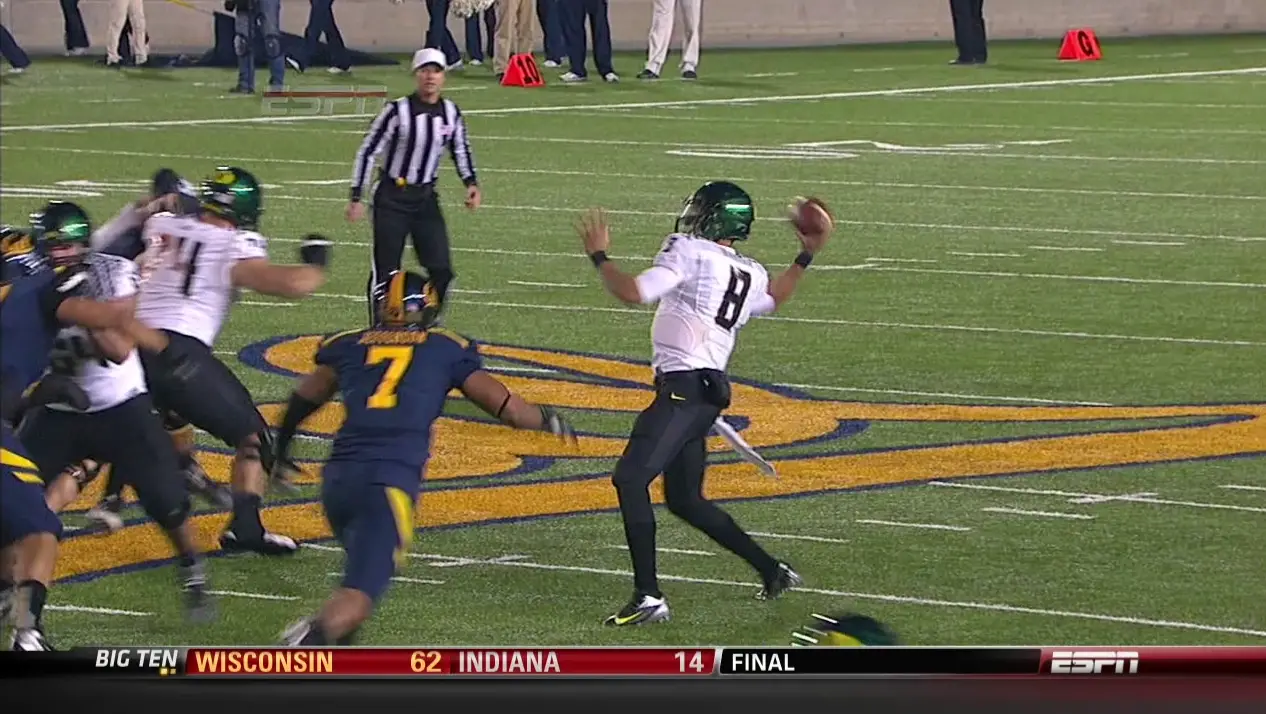There is a misconception in the pass game that the more wordy and complex the play call sounds, the more effective it is. Generations of fans and coaches grew up on NFL Films and remember audio of long and seemingly never-ending play calls by legendary coaches. These intricate sounding schemes allegedly created wide open receivers, yet this perception is quite a disconnect from reality. Rattling off “Green Left Slot Flash Pass 312 Weak Double Hitch Quick Lookie” can be as confusing as it is long. An effective passing game is not defined by run-on play call sentences or it’s difficulty to learn; it is defined by its production.
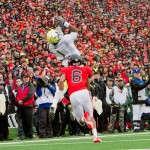
Josh Huff
Oregon offense digital film unveiled a passing scheme that generated 35 touchdowns through the air in 2012, often in “explosive” (20 yards or more) fashion. Despite the perception that the Ducks lack a down field element to its passing game, our study came to a different conclusion of the Oregon aerial attack. The Ducks revealed a scheme that attacks all areas of the field and displays the passing concepts of NFL and West Coast offenses. The difference is that Oregon threw more touchdown passes than most NFL teams did last year with significantly fewer attempts and a lot less verbiage!
The best offenses tie in their pass game to the strongest elements of their run and screen games, thus the most intriguing part of the Oregon passing game is how well this is accomplished. The best passing schemes are simple, allowing players to learn them quickly, play fast and subsequently get open. We learned how the Oregon running game was enhanced by the threats off the Bubble Zone Read in this analysis recently. This week’s article will demonstrate how the Oregon offense simply and effectively ties in the Inside Zone Read and the Bubble Zone Read to create big plays down the field. Pretty exciting!
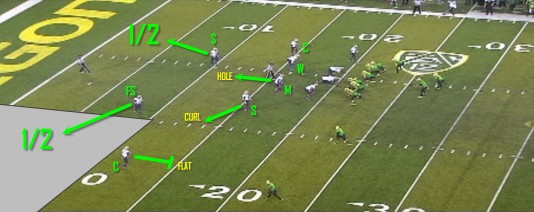
In the play pictured above, Washington tries to slow the bubble screen by playing a Cover 2 look versus a 2 tight end, 2 receiver formation of Oregon. The Cover 2 scheme places a corner close to the line of scrimmage and squarely in the flat area. The 2-deep look, with a safety in the deep half coverage over top of the corner, should discourage passing from this personnel grouping. However, Oregon’s frequent and effective usage of the bubble screen puts this coverage to the test.
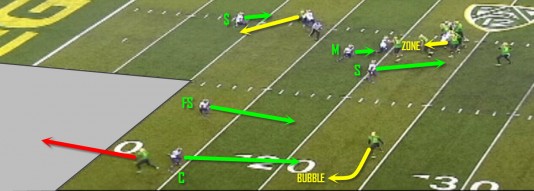
Oregon attacks this coverage with a scheme that is simple to execute and beautifully tied in to the rest of its offense. At the snap, the offset running back fakes inside zone to the right. This moves the underneath linebacker coverage (the M and S above) towards the line of scrimmage. The speed of the bubble from the slot receiver and great pump fake by Mariota busts the zone. Both the corner and free safety vacate their coverage areas to defend the bubble. Mariota’s first read is the outside receiver running down the numbers at the bottom of the screen. He delivers the ball into the exact area of the field left open by the defenders reacting to the Bubble Zone Read action for a glorious touchdown that is so successful that it appears the Huskies had a busted coverage!
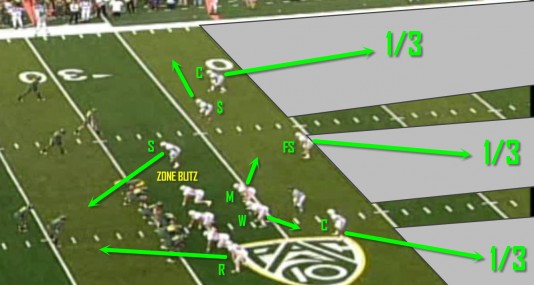
Against Stanford in 2010 above, Oregon ran a Bubble Vertical concept out of a 4×1 (3 receivers, 1 tight end) unbalanced formation. Stanford counters this unbalanced look with a 3 deep 3 under zone pressure from both edges (this formation is a popular one for Oregon). In this 3 deep zone the 2 corners and the free safety are responsible for the three deepest areas of the field. With 3 receivers and a tight end on the same side. This formation is an Oregon favorite to run the Bubble Zone Read, and the Cardinals know it. The Ducks will use this tendency to set up their play action!
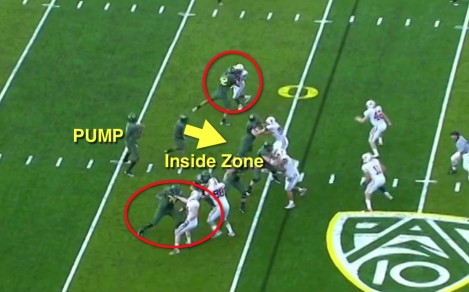
Like all great pass plays, the success of this one starts with Oregon’s pass protection. The blitz pickup negates both Stanford edge rushers, as the tight end stays in to protect and blocks the field rusher (S) and the right tackle picks up the edge rusher from the boundary (R). The clean pocket and throwing lane allows the QB to see the field clearly.
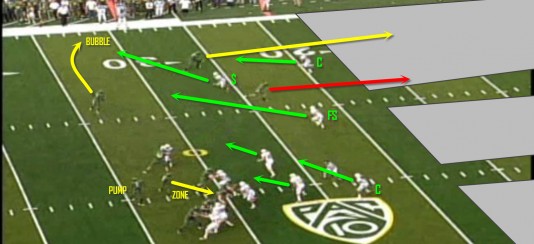
In this formation, the QB will look at the No. 2 (slot) receiver running the seam route (in Red above) first, then progress to outside vertical route. If both receivers are covered he will check the ball down to the bubble runner. At the snap, the running back fakes the inside zone to the right, and the #3 inside receiver sprints his bubble path. The action of the running back and bubble runner, combined with a great pump fake from Darron Thomas, gets the corner and free safety to abandon their deep third responsibility. With the seam uncovered Thomas gets the ball to his first read for the wide open touchdown!
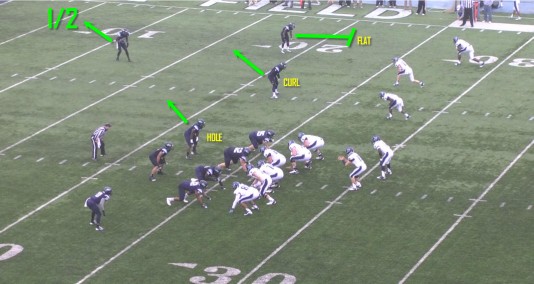
We get a lot of similar defensive alignments in response to our Spread sets at Villanova and our frequent use of Bubble screens like the Ducks. This past season Maine defended our three extended receivers with a Cover 2 look. Much like Washington, Maine wanted to discourage the Bubble throw with a hard corner and the wide leverage of their alley defender.

Our call combines a Post-Wheel pattern concept with our Bubble Zone Read action. Our widest receiver will run a post or vertical depending on the coverage. Against a Cover 2 look he is going to run an inside vertical trying to pull the free safety away from the wheel pass pattern on the outside. Our No. 2 (slot) receiver will show a run block for 5 yards, and after coming to balance at 5 yards the slot will then run the fade/wheel ending up halfway between the bottom of the numbers and the sideline. Our No. 3 inside receiver sprints the bubble; trying to bring as many defenders out of their coverage responsibilities as he can.
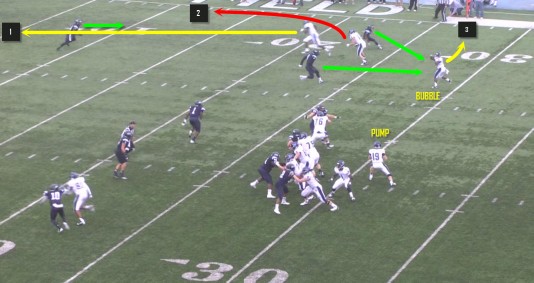
When the ball is snapped, both underneath defenders react immediately towards the Bubble screen threat. This leaves the free safety outnumbered in his deep zone, as he is responsible for both No. 1 and 2 outside receivers of Villanova entering his space!
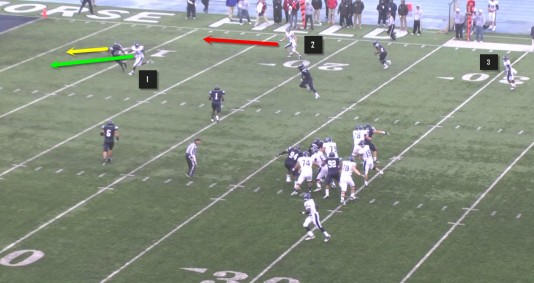
Our outside receiver (Green above) does a great job occupying and then moving the free safety away from the wheel route run by our #2 wide out (Red above). With his #1 look covered, our QB progresses to #2 receiver, who is wide open for a touchdown because of a well set up play call and great execution by the other receivers in their patterns. One thing that Wildcats and Ducks have in common is how we both love to use the threat of the Inside Zone Read and the Bubble Zone Read to create long ball touchdowns!
It is rarely a great scheme or play call by itself that makes the winning difference. A play call is only a good one if it utilizes what your players do well and puts them in position to do it. The beauty of the Oregon passing game is that it accomplishes both by building off of its No Huddle operation, dominant run game, and constraint plays. After studying the Oregon offense over the past few seasons you can see the consistent philosophical thread that combines all these different schemes together. While the Ducks pass game may appear simple, it attacks all areas of the field in a manner that is effective, efficient and explosive. Simplicity like this is one all coaches should strive for!
At Villanova University (near Philadelphia, Pennsylvania) “we love to learn about your beloved Ducks!”
Brian Flinn
Receivers Coach
Villanova University
Twitter: @Coach_Flinn
——————————————————————————————————————————-
ANNOUNCEMENTS
*If you would like to join the other 80+ volunteers at FishDuck.com, and have five hours a week to donate…we have slots open for Editors, Writers, Analysts, Photo Archivists, and Social Media Associates. Can you help us manage people? Consider our Sales Manager and HR Manager positions. E-mail us at charles@fishduck.com
*Don’t miss our football analysis every Tuesday, our Recruiting Update every Wednesday, and our new Chip Kelly updates every Friday!
Related Articles:
Coach Brian Flinn (Football Analyst) is entering his seventh year as Villanova University’s Wide Receivers Coach and Recruiting Coordinator. A native of Youngstown, OH, Brian Flinn was an All-OAC tight end at Mount Union College before entering the coaching ranks. In addition to Villanova, Coach Flinn has coached at Eastern Illinois University, Drake University, Maryland University, and Mount Union.
Go Villanova Wildcats!

